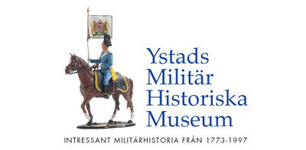The Hussar Epoch in Ystad 1773-1882
| As early as 1772, six squadrons from the Swedish Hussar Regiment had passed through the Port of Ystad on their way from the Island of Rügen to billets along the coastline of the counties of Scania and Halland. At that time Vorpommern and Rügen in the north of Germany, were Swedish territory. In 1773, one squadron, called Mörner’s Hussars, was billeted in Ystad. The squadron comprised roughly 50-100 men and horses. (Mörner’s Hussars was later renamed The Crown Prince’s Hussar Regiment [K7]). [K7] The Hussars were a so-called drafted regiment, that is to say, permanent recruits. They were housed with well-to-do townsfolk and house owners in Ystad. The population of the town at that time was roughly 2,500 excluding about 300 Hussars and their family members. The model shows the first stables built for the Hussars’ horses. These stables were built near” Klostret” (the Monastery) during the 1770´s. (14). In 1791, yet another squadron of Hussars was billeted in Ystad. (15) On the wall you can see a map of Ystad as it was when the Hussars first arrived in 1793. (15).1(16) In 1813, the Ystad unit of the Hussar Regiment [K7] was billeted in new barracks on a street called Stora Östergatan.[K 7] On the right you can see a model of those barracks. (16). |
Besides his cavalry sword, a Hussar had a sabre bag, “sabeltaska” in which he could keep maps, written orders etc. In the glass display case, there is both a “sabeltaska” and a Hussar sabre. (17).
The Hussar Regiment’s new barracks on Stora Östergatan. IA large representation of the standard (The victory banner) of the Crown Prince’s Hussar Regiment inscribed with the victorious name “Bornhöft 1813”. (18). Bornhöft (known as Bornhoved in English) is the name of a town that lies in Northern Germany where the last armed conflict between Sweden and Denmark took place. This was also the last time that Swedish cavalry fought in a battle. |



